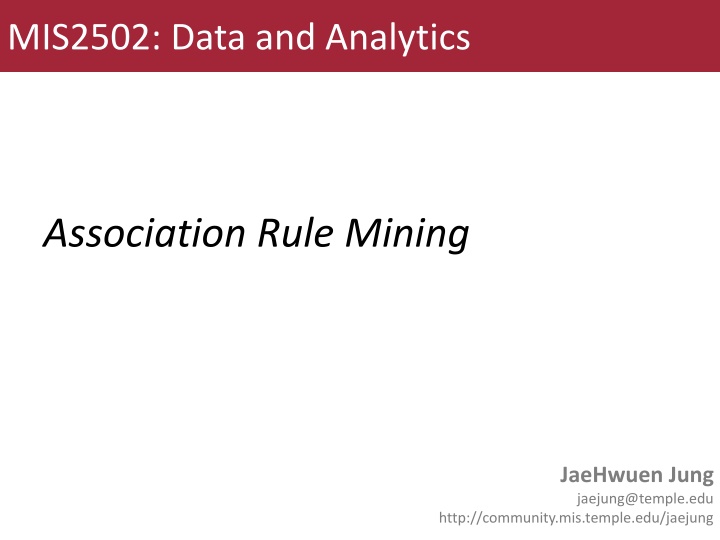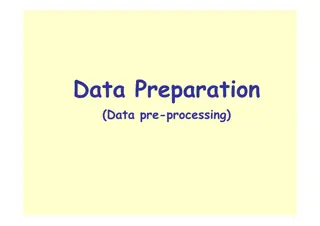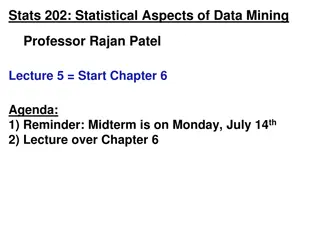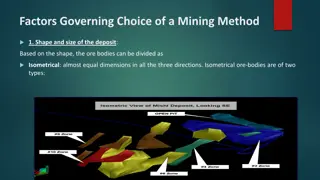
Association Rule Mining and Market Basket Analysis
Learn about Association Rule Mining and Market Basket Analysis in data analytics, illustrated through examples like the Amazon Recommender System and the intriguing case of beer and diapers correlation. Explore how to find associations between products in market basket transactions.
Uploaded on | 2 Views
Download Presentation

Please find below an Image/Link to download the presentation.
The content on the website is provided AS IS for your information and personal use only. It may not be sold, licensed, or shared on other websites without obtaining consent from the author. If you encounter any issues during the download, it is possible that the publisher has removed the file from their server.
You are allowed to download the files provided on this website for personal or commercial use, subject to the condition that they are used lawfully. All files are the property of their respective owners.
The content on the website is provided AS IS for your information and personal use only. It may not be sold, licensed, or shared on other websites without obtaining consent from the author.
E N D
Presentation Transcript
MIS2502: Data and Analytics Association Rule Mining JaeHwuen Jung jaejung@temple.edu http://community.mis.temple.edu/jaejung
Association Rule Mining my+REWARDS CARD Application Find out which items predict the occurrence of other items Also known as affinity analysis or market basket analysis
Case 1: Amazon Recommender System Figure: Amazon recommendations while viewing a book
Case 2: The parable of the beer and diapers It goes (with minor variations) like this: Some time ago, one retail store decided to combine the data from its loyalty card system with that from its point of sale systems. The former provided the store with demographic data about its customers, the latter told it where, when and what those customers bought. Once combined, the data was mined extensively and many correlations appeared. Some of these were obvious; people who buy gin are also likely to buy tonic. However, one correlation stood out like a sore thumb because it was so unexpected. On Friday afternoons, young American males who buy diapers also have a predisposition to buy beer. No one had predicted that result, so no one would ever have even asked the question in the first place.
Market-Basket Transactions Basket Items Bread, Milk 1 Bread, Diapers, Beer, Eggs Milk, Diapers, Beer, Coke 2 3 Bread, Milk, Diapers, Beer 4 Bread, Milk, Diapers, Coke 5 We usually start from a data set like this with baskets of transactions And the idea is to find associations between products
Market-Basket Transactions Basket Items Bread, Milk 1 Bread, Diapers, Beer, Eggs Milk, Diapers, Beer, Coke 2 3 Bread, Milk, Diapers, Beer 4 Bread, Milk, Diapers, Coke 5 X Y consequent) (aka LHS RHS) {Diapers} {Beer}, {Milk, Bread} {Diapers} {Beer, Bread} {Milk}, {Bread} {Milk, Diapers} (antecedent Association Rules from these transactions
Core idea: The itemset Itemset A group of items of interest {Milk, Diapers, Beer} Basket Items Bread, Milk Association rules express relationships between itemsets X Y {Milk, Diapers} {Beer} 1 Bread, Diapers, Beer, Eggs 2 Milk, Diapers, Beer, Coke 3 Bread, Milk, Diapers, Beer 4 Bread, Milk, Diapers, Coke 5 when you have milk and diapers, you are also likely to have beer
Support Count () Basket Items Support count ( ) In how many baskets does the itemset appear? {Milk, Diapers, Beer} = 2 (i.e., in baskets 3 and 4) Bread, Milk 1 Bread, Diapers, Beer, Eggs 2 Milk, Diapers, Beer, Coke 3 Bread, Milk, Diapers, Beer 4 Bread, Milk, Diapers, Coke 5 X Y 2 baskets have milk, beer, and diapers You can calculate support count for both X and Y separately {Milk, Diapers} = ? {Beer} = ? 5 baskets total
Support (s) Basket Items Support (s) Fraction of transactions that contain all items in the itemset Bread, Milk 1 Bread, Diapers, Beer, Eggs 2 Milk, Diapers, Beer, Coke 3 Bread, Milk, Diapers, Beer 4 s({Milk, Diapers, Beer}) Bread, Milk, Diapers, Coke 5 X Y = {Milk, Diapers, Beer} /(# of transactions) =2/5 = 0.4 This means 40% of the baskets contain Milk, Diapers and Beers You can calculate support for both X and Y separately Support for X: s{Milk, Diapers}= ? Support for Y: s{Beer}= ?
Confidence (c) Confidence (c) is the strength of the association Measures how often items in Y appear in transactions that contain X Basket Items Bread, Milk 1 Bread, Diapers, Beer, Eggs 2 Milk, Diapers, Beer, Coke 3 Bread, Milk, Diapers, Beer 4 Bread, Milk, Diapers, Coke 5 X ( ) s X Y Support for total itemset X and Y = ( ) c X Y ( ) s Support for X ( Milk, s Diapers, Beer ) 4 . 0 s = = = . 0 67 ( Milk , Diapers ) 6 . 0 This says 67% of the times when you have milk and diapers in the itemset you also have beer! c must be between 0 and 1 1 is a complete association 0 is no association
Basket Items Bread, Milk Calculating and Interpreting Confidence 1 Bread, Diapers, Beer, Eggs 2 Milk, Diapers, Beer, Coke 3 Bread, Milk, Diapers, Beer 4 Bread, Milk, Diapers, Coke 5 Association Rule (a b) {Milk,Diapers} {Beer} Confidence (a b) What it means 2 baskets have milk, diapers, beer 3 baskets have milk and diapers So, 67% of the baskets with milk and diapers also have beer 0.4/0.6 = 2/3= 0.67 {Milk,Beer} {Diapers} 2 baskets have milk, diapers, beer 2 baskets have milk and beer So, 100% of the baskets with milk and beer also have diapers 0.4/0.4 = 2/2= 1.0 {Milk} {Diapers,Beer} 2 baskets have milk, diapers, beer 4 baskets have milk So, 50% of the baskets with milk also have diapers and beer 0.4/0.8 = 2/4 = 0.5
But dont blindly follow the numbers i.e., high confidence suggests a strong association But this can be deceptive Consider {Bread} {Diapers} Support for the total itemset is 0.6 (3/5) And confidence is 0.75 (3/4) pretty high But is this just because both are frequently occurring items (s=0.8)? You d almost expect them to show up in the same baskets by chance
Lift Takes into account how co-occurrence differs from what is expected by chance i.e., if items were selected independently from one another ( ) s X Y Support for total itemset X and Y = ( ) Lift X Y ( ) * ( ) s X s Y Support for X times support for Y
What does the Lift mean? Recall that ? ? ? =? ? ? ?(?) Thus, we can re-write Lift as ? ? ? ? ? ? ? ? ? ? ? ? ? ? =? ? ? ? ? ???? ? ? = = ? ? ? : how often items in Y appear in transactions that contain X ?(?): how often items in Y appear in all transactions The occurrence of X Y together is more likely than what you would expect by chance (? ? ? ? ? The occurrence of X Y together is less likely than what you would expect by chance The occurrence of X Y together is the same as what you would expect by chance (i.e. X and Y are independent of each other) Lift > 1 > ?) Lift<1 Lift=1
Lift Example Basket Items Bread, Milk 1 What s the lift for the rule: {Milk, Diapers} {Beer} Bread, Diapers, Beer, Eggs 2 Milk, Diapers, Beer, Coke 3 Bread, Milk, Diapers, Beer 4 Bread, Milk, Diapers, Coke So X = {Milk, Diapers} Y = {Beer} 5 When Lift > 1, the occurrence of X Y together is more likely than what you would expect by chance s({Milk, Diapers} {Beer}) = 2/5 = 0.4 s({Milk, Diapers}) = 3/5 = 0.6 s({Beer}) = 3/5 = 0.6 s Y X Lift = ( ) X Y ( ) So ( ) * ( ) s X s Y 4 . 0 4 . 0 {Beer}) = = . 1 = ({Milk, Diapers} 11 Lift 6 . 0 6 . 0 * . 0 36
Another example Netflix What is the effect of Netflix on Cable TV? (Netflix CableTV) No Yes Cable TV No 200 3800 Yes 8000 1000 Total = 200 + 3800 + 8000 + 1000 = 13000 = 1000/13000 7.7% = (8000+1000)/13000 69.2% = (3800+1000)/13000 36.9% People with both services People with Cable TV People with Netflix 0.692 0.369=0.07 0.077 ???? Netflix CableTV = 0.24= 30% Having one negatively affects the purchase of the other (lift < 1)
Selecting the rules We know how to calculate the measures for each rule Support Confidence Lift The steps List all possible association rules Compute the support and confidence for each rule Drop rules that don t make the thresholds Use lift to further check the association Then we set up thresholds for the minimum rule strength we want to accept
Once you are confident in a rule, take action {Diapers} {Beer} Possible Marketing Actions Put diaper next to beer in the store Put diaper away from beer in the store (why?) Bundle beer and diaper into New Parent Coping Kit What are some others?
Summary Support, confidence, and lift Explain what each means Can you have high confidence and low lift? How to compute In-Class Activity: Part 1: Computing Confidence, Support, and Lift Part 2: Association Rule Mining Using R
Support Fraction of transactions that contain all items = ( , ) X Y ( ) S X Y # _ _ of transactio ns Confidence Measures how often items in Y appear in transactions that contain X ( ) ( , ) /# _ of _ transactio ( , ) s X Y X Y of transactio ns X Y = == = ( ) C X Y ( ) ( ) /# _ _ ( ) s X X ns X Lift How co-occurrence differs from what is expected by chance ? ? ? ? ? ? ? ? ? ? ? ? ? ? =? ? ? ? ? ???? ? ? = =





















